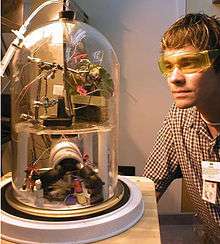Bell jar
A bell jar is a glass jar, similar in shape to a bell, and can be manufactured from a variety of materials (ranging from glass to different types of metals). Bell jars are often used in laboratories to form and contain a vacuum. It is a common science apparatus used in experiments.[1] Bell jars have a limited ability to create strong vacuums; Vacuum chambers are available when higher performance is needed.
 Early 20th century bell jar with a vacuum pump | |
| Uses | Enclosing objects, containing gases or a vacuum |
|---|---|
Bell jars may also serve as display cases or transparent dust covers.It is also used in many experiments like sound propagation.
Vacuum

A vacuum bell jar is placed on a base which is vented to a hose fitting, that can be connected via a hose to a vacuum pump. A vacuum is formed by pumping the air out of the bell jar.
The lower edge of a vacuum bell jar forms a flange of heavy glass, ground smooth on the bottom for better contact. The base of the jar is equally heavy and flattened. A smear of vacuum grease is usually applied between them. As the vacuum forms inside, it creates a considerable compression force, so there is no need to clamp the seal. For this reason, a bell jar cannot be used to contain pressures above atmospheric, only below.
Bell jars are generally used for classroom demonstrations or by hobbyists, when only a relatively low-quality vacuum is required. Cutting-edge research done at ultra high vacuum requires a more sophisticated vacuum chamber. However, several tests may be completed in a bell jar chamber having an effective pump and low leak rate.
An example of a classroom science experiment involving a bell jar is to place a ringing alarm clock under the bell jar. As the air is pumped out of the sealed bell jar, the noise of the alarm clock fades, thus demonstrating that the propagation of sound is mediated by the air. In the absence of their medium, the sound waves cannot travel.[2]
A vacuum produces a pressure difference of one atmosphere, approximately 14 psi, over the surface of the glass. The energy contained within an implosion is defined by the pressure difference and the volume evacuated. Flask volumes can change by orders of magnitude between experiments. Whenever working with liter sized or larger flasks, chemists should consider using a safety screen or the sash of a flow hood to protect them from shards of glass, should an implosion occur. Glassware can also be wrapped with spirals of tape to catch shards, or wrapped with webbed mesh more commonly seen on scuba cylinders.
Glass under vacuum becomes more sensitive to chips and scratches in its surface, as these form strain accumulation points, so older glass is best avoided if possible. Impacts to the glass and thermally induced stresses are also concerns under vacuum. Round bottom flasks more effectively spread the stress across their surfaces, and are therefore safer when working under vacuum.
Decorative or preservative
Purely decorative bell jars were commonly used in the Victorian period to display and serve as transparent dust covers for clocks and taxidermy. Decorative bell jars were made of thin glass, with more care being taken regarding their optical clarity, and they did not have a thickened base flange. For this reason, they are not suitable for vacuum use and would usually fail if pumped down.
Similar glass domes were used as cheese domes or garden cloches.
In popular culture
- "The Jar" (November 1944) is a short story by Ray Bradbury, published in Weird Fiction
- The Bell Jar (1963) is a roman à clef by Sylvia Plath, originally published under the pen name "Victoria Lucas"
See also
References
- Bell Jar, National Museum of American History, 2009, retrieved 15 November 2019
- "Bell Jar Experiment". Amrita University.